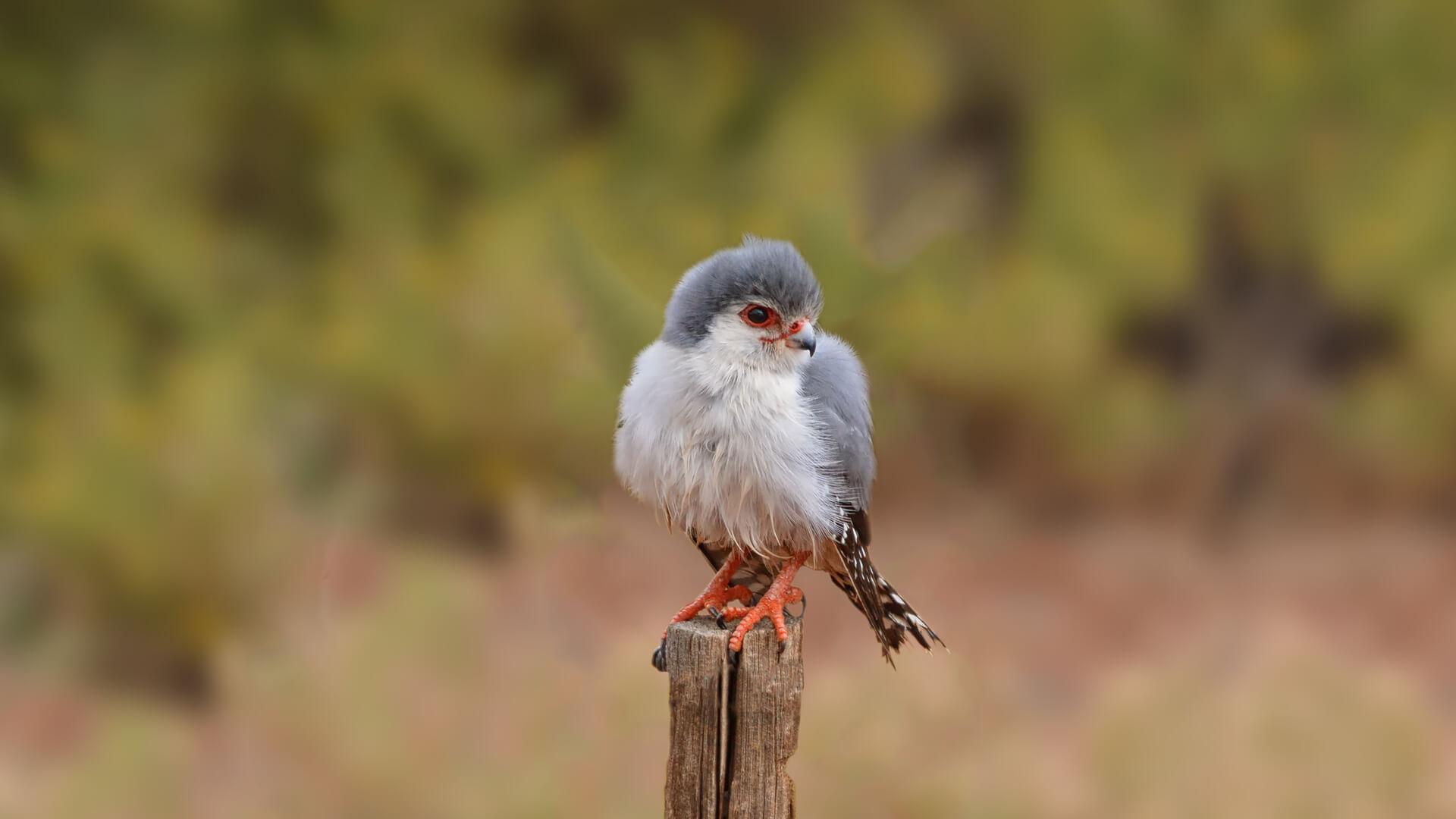
African Pygmy Falcon
African Pygmy Falcon
The African Pygmy Falcon: A Tiny Raptor with a Mighty Spirit. Birding Safari Uganda
Introduction
The African Pygmy Falcon (Polihierax semitorquatus) is one of the smallest birds of prey in the world, yet it possesses an outsized presence in the arid landscapes of East Africa. With its striking plumage, unique nesting habits, and fierce hunting prowess, this diminutive raptor is a marvel of avian adaptation. In this comprehensive guide, we delve into the world of the African Pygmy Falcon, exploring its habitat, behavior, diet, and conservation status, while also linking to valuable resources like Turkana Wildlife Safaris for those eager to witness this bird in its natural environment.
Overview of the African Pygmy Falcon
The African Pygmy Falcon is the smallest raptor in Africa, measuring only about 20 cm (8 inches) in length and weighing around 50-70 grams. Despite its size, it is a formidable predator, preying on insects, small reptiles, and even birds.
- Scientific Name: Polihierax semitorquatus
- Family: Falconidae
- Habitat: Arid and semi-arid savannas, thornbush, and open woodlands
- Range: Eastern and Southern Africa, particularly in countries like Kenya, Ethiopia, and Namibia
For travelers interested in observing this bird in its natural habitat, Turkana Wildlife Safaris offers specialized birding tours across Kenya’s remote regions.
Habitat and Distribution
Preferred Environment
The African Pygmy Falcon thrives in dry, open areas where it can perch on acacia trees or termite mounds to scout for prey. It is commonly found in:
- Savannas and scrublands
- Dry thornbush areas
- Open woodlands with scattered trees
These habitats are abundant in northern Kenya, particularly in the Turkana region, making it a prime location for birdwatchers. Explore Turkana’s unique ecosystems to understand why this area supports such a diverse avifauna.
Geographic Range
The species is divided into two subspecies:
- Polihierax semitorquatus castanonotus – Found in southern Africa
- Polihierax semitorquatus semitorquatus – Found in East Africa, including Kenya and Ethiopia
This distribution allows for a wide range of ecological interactions and adaptations, which we’ll explore further below.
Physical Characteristics
Despite its small size, the African Pygmy Falcon is easily recognizable due to its distinctive features:
- Coloration: Males have a white face and underparts with a gray back, while females have a chestnut-colored back.
- Eyes: Large, dark eyes adapted for spotting prey from a distance.
- Beak: Short, hooked beak typical of raptors, used for tearing flesh.
This bird’s compact body and swift flight make it a master of aerial agility, ideal for catching fast-moving prey.
Behavior and Social Structure
Hunting and Diet
The African Pygmy Falcon is a carnivorous predator that feeds on:
- Small lizards
- Insects (especially grasshoppers and beetles)
- Small birds and rodents
It hunts from a perch, swooping down with precision to snatch prey. Its hunting style is similar to that of larger falcons but adapted to its size and environment.
Unique Nesting Habits
One of the most fascinating aspects of this bird is its nesting behavior. Unlike many raptors, the African Pygmy Falcon does not build its own nest. Instead, it takes over the communal nests of sociable weavers, forming a rare symbiotic relationship.
- Benefits to the Falcon: Ready-made shelter, protection in numbers
- Benefits to the Weaver: Falcons deter predators like snakes and larger birds
This mutualistic relationship is a rare example of interspecies cooperation in the avian world.
Reproduction and Lifespan
Breeding Season
Breeding typically occurs during the dry season when food is more abundant. The female lays 2–4 eggs, which are incubated for about 30 days.
Parental Care
Both parents share in feeding and protecting the chicks. The young fledge after approximately 30 days but may remain with the parents for weeks afterward.
Lifespan
In the wild, the African Pygmy Falcon can live up to 10 years, although predation and environmental factors often reduce this average.
Conservation Status
Threats
While not currently endangered, the African Pygmy Falcon faces several threats:
- Habitat loss due to agriculture and urbanization
- Climate change, which alters prey availability
- Human disturbance, especially in nesting areas
Conservation Efforts
Organizations like Turkana Wildlife Safaris are actively involved in promoting eco-tourism and conservation education to protect species like the African Pygmy Falcon.
IUCN Status
According to the IUCN Red List, the African Pygmy Falcon is listed as Least Concern, but ongoing monitoring is essential to ensure its continued survival.
Cultural Significance and Ecotourism
In many African cultures, birds of prey are symbols of strength and agility. The African Pygmy Falcon, despite its size, is revered for its hunting prowess and adaptability.
Birdwatching in Kenya
Kenya is a hotspot for birdwatchers, and the Turkana region is particularly rich in endemic and migratory species. Birding safaris offered by Turkana Wildlife Safaris provide an excellent opportunity to spot the African Pygmy Falcon along with hundreds of other species.
Why Choose Turkana?
- Expert local guides
- Customizable itineraries
- Access to remote and pristine habitats
Fascinating Facts About the African Pygmy Falcon
- It is one of the few raptors that engage in communal living with another species.
- Despite its size, it can take down prey nearly its own weight.
- It often uses the same nest for multiple breeding seasons.
- Its call is a high-pitched “ki-ki-ki,” often heard during territorial disputes.
- It can survive in extremely arid environments with minimal water.
How to Spot the African Pygmy Falcon
Best Locations
- Lake Turkana Basin – A UNESCO World Heritage Site
- Samburu National Reserve
- South Horr and Loiyangalani regions
Best Time to Visit
- Dry Season: June to October and January to March
- Birding Peak: November to February (when migratory species are present)
For personalized birding experiences, check out Turkana Wildlife Safaris’ birding packages.
Frequently Asked Questions (FAQ)
1. Where can I see the African Pygmy Falcon in Kenya?
You can spot this bird in arid regions such as the Turkana Basin, Samburu, and the Chalbi Desert. Turkana Wildlife Safaris offers guided tours to these locations.
2. Is the African Pygmy Falcon endangered?
No, it is currently listed as Least Concern by the IUCN, but habitat loss and climate change pose future risks.
3. What does the African Pygmy Falcon eat?
Its diet includes insects, lizards, and small birds. It hunts from perches and uses swift aerial attacks to capture prey.
4. How does it interact with sociable weavers?
It nests in the communal nests of sociable weavers, benefiting from their structure and providing protection in return.
5. Can I photograph the African Pygmy Falcon?
Yes! The bird is relatively approachable during safaris. Turkana Wildlife Safaris offers specialized photography tours for bird enthusiasts.
Conclusion
The African Pygmy Falcon is a testament to nature’s ingenuity—a small bird with a large ecological footprint. Its unique behaviors, symbiotic relationships, and adaptability make it a fascinating subject for ornithologists and bird lovers alike. Whether you’re a seasoned birder or a curious traveler, witnessing this miniature raptor in the wild is a rewarding experience.
For those ready to embark on a journey into the heart of Africa’s birding paradise, Turkana Wildlife Safaris offers the perfect gateway to explore the untamed beauty of Kenya and its avian treasures.
